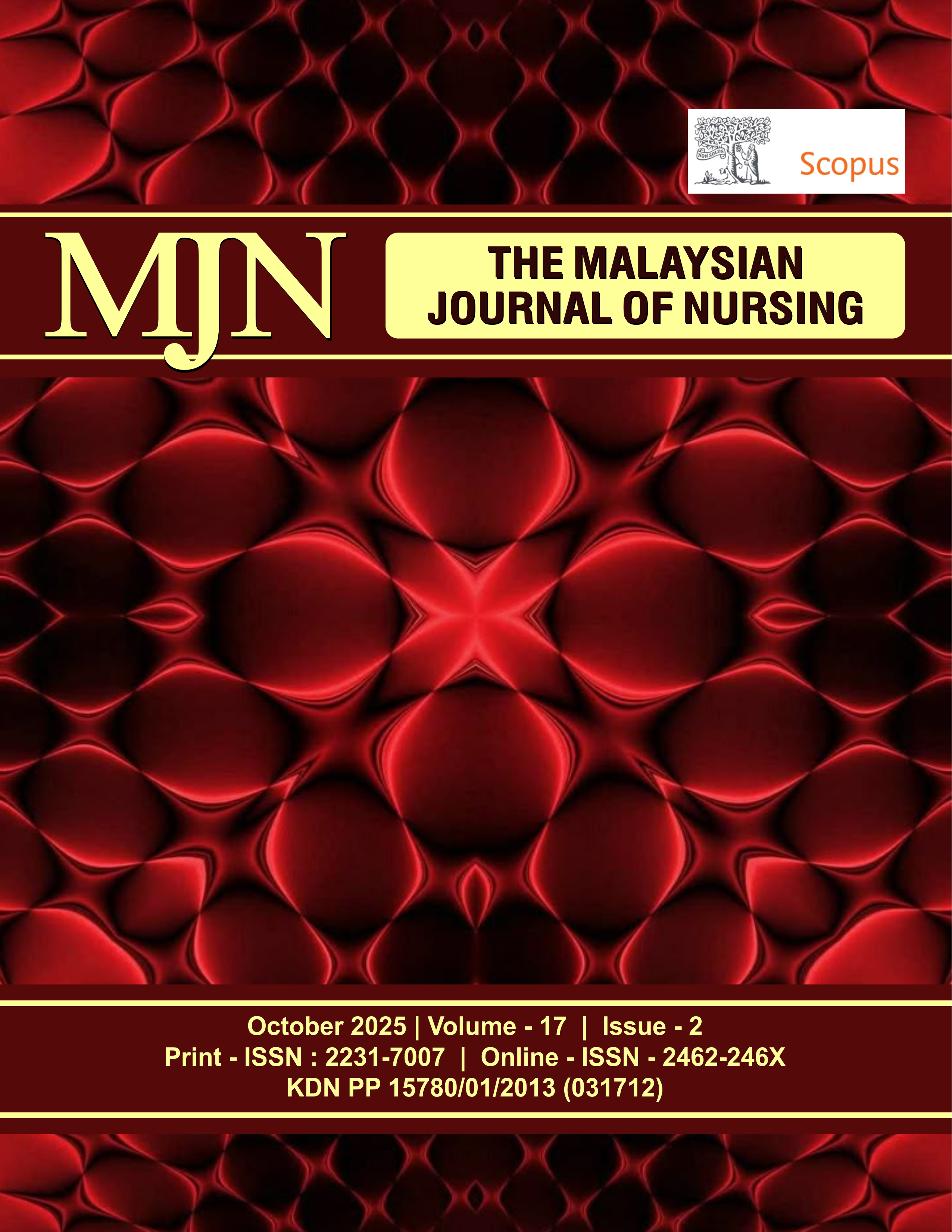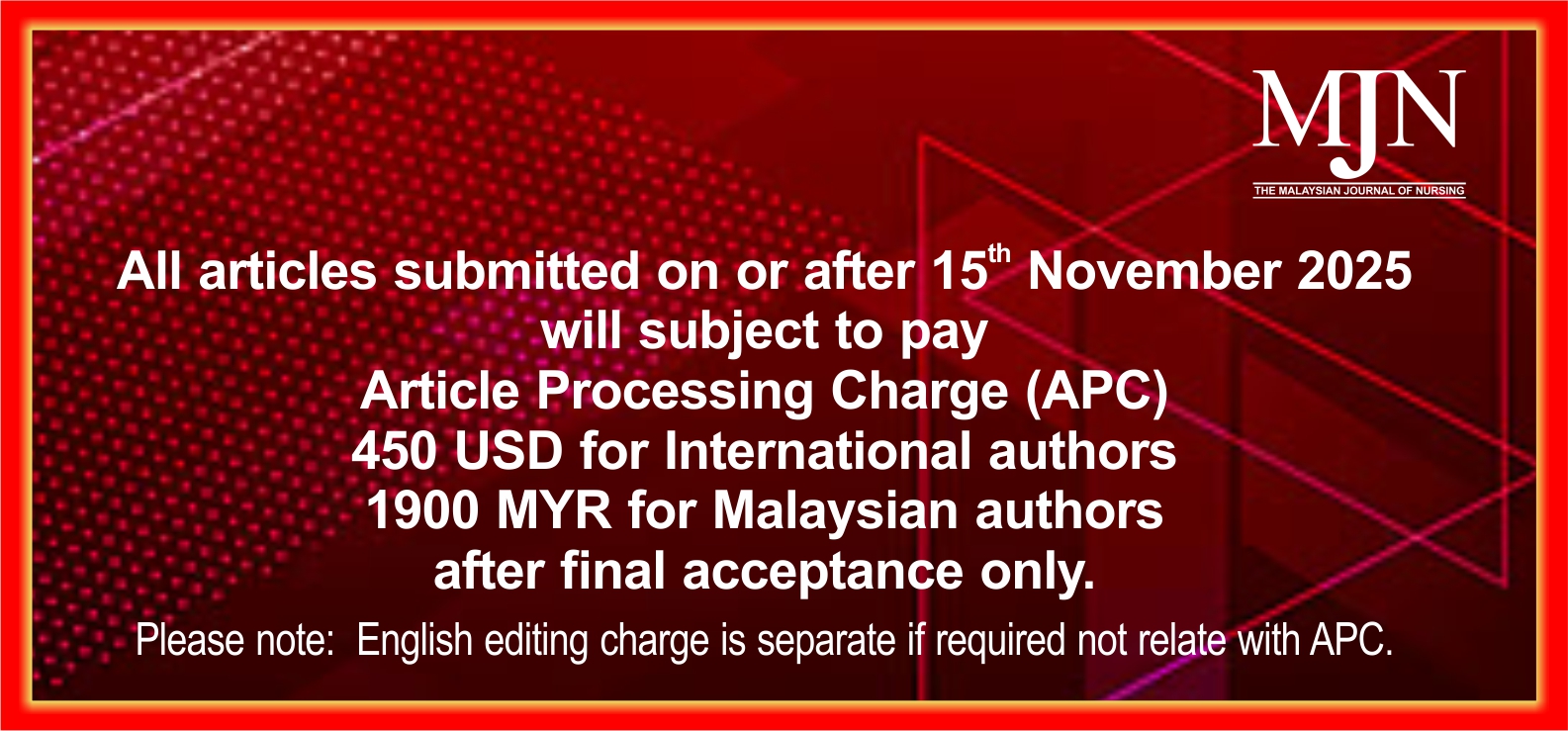Nursing Intervention for Enhancing Blood Transfusion Experience in Thalassemic Children
DOI:
https://doi.org/10.31674/mjn.2025.v17i02.008Abstract
Background: Children with thalassaemia require frequent and prolonged blood transfusions as part of their treatment, which often leads to physical discomfort and emotional distress, negatively affecting their overall well-being and cooperation during procedures. Nursing care plays a critical role in mitigating these challenges and improving patient comfort. Deep breathing is a simple, non-pharmacological technique that has been shown to reduce anxiety and discomfort while positively influencing physiological functions; however, its effectiveness varies among individuals. Objective: This study aimed to evaluate the effectiveness of deep breathing exercises in stabilising key physiological parameters (heart rate, respiratory rate, blood pressure, oxygen saturation, and temperature) among children with thalassaemia undergoing blood transfusion. Methods: A quasi-experimental design was conducted with 80 children diagnosed with thalassaemia at the Thalassaemia Center for Genetic Blood Disorders. Participants were assigned to either an intervention group or a control group using convenience sampling. The intervention group performed deep breathing exercises during transfusion, while the control group received standard care. Physiological parameters, including heart rate, respiratory rate, and blood pressure, were measured before, during, and after transfusion. Data were analysed using SPSS software. Results: The intervention group showed significant improvements in physiological parameters compared with controls. Heart rate and respiratory rate decreased significantly (p = 0.001 and p < 0.001, respectively), while oxygen saturation increased (p < 0.001). No significant change was found in blood pressure (p = 0.12). These findings confirm the effectiveness of deep breathing in stabilising physiological responses during transfusion. Conclusion: Deep breathing exercises are an effective nursing intervention that improves physiological stability and enhances the transfusion experience for children with thalassaemia. Incorporating this simple, low-cost technique into paediatric transfusion care may promote comfort and improve clinical outcomes.
Keywords:
Blood Transfusion, Deep Breathing, Nursing Care Physiological Parameters, ThalassaemiaDownloads
References
Abdulzahra, F. A., & Shawq, A. H. (2024). Mobile application to develop nurses’ knowledge of pediatric cardiopulmonary resuscitation: A quasi-experimental study. Journal of Emergency Medicine, Trauma and Acute Care, 2024(6). https://doi.org/10.5339/jemtac.2024.absc.7
Aritonang, Y. A. (2020). the effect of slow deep breathing exercise on headache and vital sign in hypertension patients. Jurnal Keperawatan Padjadjaran, 8(2), 166–174. https://doi.org/10.24198/jkp.v8i2.1320
Bergeri, A. S., & Daruwala, S. S. (2025). Effectiveness of abdominal deep breathing exercises in managing blood pressure among hypertensive patients. Cureus, 17(2), e78393. https://doi.org/10.7759/cureus.78393
Carceller, F., Corley, E. A., King, A., Zebian, B., Mandeville, H. C., & Marshall, L. V. (2023). COVID‐related transaminitis confounding toxicity attribution in a child with brain tumour on targeted therapy. Paediatric Blood & Cancer, 70(3). https://doi.org/10.1002/pbc.29987
Chakraborty, R., Banerjee, A., & Mitra, S. (2023). Effect of diaphragmatic breathing on anxiety and vital signs in paediatric invasive procedures. Journal of Pediatric Nursing, 68, 112–119. https://doi.org/10.1016/j.pedn.2023.02.007
Chouhan, M. S., & Pujari, J. (2021). Nurses’ Knowledge and role on care of children with Thalassemia. International Journal of Health Sciences and Research, 11(3), 156-161. https://www.ijhsr.org/IJHSR_Vol.11_Issue.3_March2021/IJHSR-Abstract.025.html
Das, K. C., & Ferdousi, S. (2022). Slow breathing exercise improves cardiac autonomic dysfunction in male patients with transfusion dependent thalassemia: A power spectral analysis of heart rate variability. International Journal of Clinical and Experimental Physiology, 9(2), 88–92. https://doi.org/10.5530/ijcep.2022.9.2.18
Fadhil, A. A., & Ajil, Z. W. (2024). Nurses’ knowledge towards patients’ safety and reducing errors in paediatric hemodialysis centers. Journal of Science in Medicine and Life, 2(4), 54–60. https://www.researchgate.net/publication/382175221_Nurses'_Knowledge_towards_Patients'_Safety_and_Reducing_Errors_in_Paediatric_Hemodialysis_Centers
Hyeon, R., & Oh, W.-O. (2025). Virtual reality education for preventing safety incidents in paediatric hospital settings: Quasi-experimental design pre-post-testing. Journal of Paediatric Nursing, 80, 56–63. https://doi.org/10.1016/j.pedn.2024.11.005
Jadhav, S. K., Naregal, P. M., Mohite, V. R., & Karale, R. B. (2024). Impact of foot reflexology versus simple massage on vital signs, anxiety, and pain during blood transfusion among children with thalassemia. Cureus, 16(8), e67876. https://doi.org/10.7759/cureus.67876
Kaur, J., & Dutta, P. (2024). Integrating deep breathing and relaxation into paediatric transfusion protocols: A quasi-experimental study. Clinical Nursing Research, 33(4), 489–501. https://doi.org/10.1177/10547738241234567
Kolcaba, K. (2003). Dr. Katharine Kolcaba, RN. A Vision for Holistic Health Care and Research. Springer Publishing Company. https://pmhealthnp.com/wp-content/uploads/2019/05/Comfort-Theory-Application.pdf
Kwame, A., & Petrucka, P. M. (2021). A literature-based study of patient-centered care and communication in nurse-patient interactions: barriers, facilitators, and the way forward. BMC Nursing, 20(1), 158. https://doi.org/10.1186/s12912-021-00684-2
Ma, X., Yue, Z.-Q., Gong, Z.-Q., Zhang, H., Duan, N.-Y., Shi, Y.-T., Wei, G.-X., & Li, Y.-F. (2017). The effect of diaphragmatic breathing on attention, negative affect and stress in healthy adults. Frontiers in Psychology, 8. https://doi.org/10.3389/fpsyg.2017.00874
Mansouri, A., Shadadi, H., Poudineh-Moghadam, M., Vahed, A. S., & Dehghanmehr, S. (2017). Evaluation of the effect of foot reflexology massage on vital signs and anxiety after blood transfusions in children with thalassaemia. Bali Medical Journal, 6(3), 623-629. https://doi.org/10.15562/bmj.v6i3.622
Musallam, K. M., Cappellini, M. D., Porter, J. B., Farmakis, D., Eleftheriou, A., Angastiniotis, M., & Taher, A. T. (2025). TIF guidelines for the management of transfusion‐dependent β‐Thalassaemia. HemaSphere, 9(3), 1-5, e70095. https://doi.org/10.1002/hem3.70095
Nishikawa, A., Fujimori, Y., Sakano, N., Mushino, T., Tamura, S., Kasahara, S., Akasaka, H., & Sonoki, T. (2021). Remote vital signs data monitoring during home blood transfusion: A pilot study. Health Science Reports, 4(3), e380. https://doi.org/10.1002/hsr2.380
Panteli, M., Vun, J. S. H., Ahmadi, M., West, R. M., Howard, A. J., Chloros, G., Pountos, I., & Giannoudis, P. V. (2023). Blood loss and transfusion risk in intramedullary nailing for subtrochanteric fractures. Transfusion Medicine, 33(1), 49–60. https://doi.org/10.1111/tme.12904
Parizad, N., Goli, R., Faraji, N., Mam-Qaderi, M., Mirzaee, R., Gharebaghi, N., Baghaie, R., Feizipour, H., & Haghighi, M.-M. (2021). Effect of guided imagery on anxiety, muscle pain, and vital signs in patients with COVID-19: A randomized controlled trial. Complementary Therapies in Clinical Practice, 43, 101335. https://doi.org/10.1016/j.ctcp.2021.101335
Ramos, L. F., Pinto, S. P., & Vega, C. (2022). Nurse-led mindfulness and breathing interventions improve physiological stability in hospitalised children. BMC Nursing, 21, 295. https://doi.org/10.1186/s12912-022-01025-9
Roney, J. K., Long, J. D., Cason, E. R., Johnston, L. M., Emery, E., Deleon, M., Whitley, B. E., & Baggerly, K. (2022). Detecting blood transfusion reactions: What are vital signs anyway? Nursing Forum, 57(3), 486–490. https://doi.org/10.1111/nuf.12697
Salehipour, S., & Ghaljeh, M. (2021). The effect of Benson relaxation technique on anxiety and aggression in patients with thalassemia major: a Clinical Trial Study. Pakistan Journal of Medical & Health Sciences, 15(3), 753-758. https://pjmhsonline.com/2021/march/753.pdf
Shawq, A., Al-Musawi, K., Kalel, M., & Mahmod, A. (2025). The effects of music interventions on children's pain severity and anxiety during dressing changes in Iraq: A randomized controlled trial. Jurnal Keperawatan Soedirman, 20(1), 43-50. https://doi.org/10.20884/1.jks.2025.20.1.13100
Shawq, A. H. (2024). Effectiveness of deep breathing technique on pain level of school children during catheterization. Medical Journal of Babylon, 21(Suppl 1), S120–S125. https://doi.org/10.4103/mjbl.mjbl_258_23
Shawq, A. H., & Ali, E. G. (2019). Body image and physical perception of children with precocious puberty in Baghdad city. Indian Journal of Public Health Research & Development, 10(9), 587. https://doi.org/10.5958/0976-5506.2019.02494.X
Sheikhi, A. R., Naderifar, M., Abdullahi M. A, Mastalizadeh, H., Sheikhi, H. R. (2020). The effect of music therapy on the anxiety level of children with thalassemia major under blood transfusion. Archives Pharmacy Practice 2020,11(4), 66-69. https://surl.li/poiean
Sullivan, K. D., Richardson, G., Castillo, E., & Martinez, F. (2015). Evaluating the frequency of vital sign monitoring during blood transfusion: An evidence-based practice initiative. Clinical Journal of Oncology Nursing, 19(5), 516–520. https://doi.org/10.1188/15.CJON.516-520
Weydert, J. A., Shapiro, D. E., Acra, S. A., Monheim, C. J., Chambers, A. S., & Ball, T. M. (2006). Evaluation of guided imagery as treatment for recurrent abdominal pain in children: A randomized controlled trial. BMC Pediatrics, 6(1), 29. https://doi.org/10.1186/1471-2431-6-29
Yendodu, V., Nirmala, S., & Nuvvula, S. (2023). Effect of deep breathing exercise using smartwatch on behaviour, anxiety and pain in children during buccal infiltration anaesthesia-a randomised clinical trial. Journal of Clinical and Diagnostic Research, 17(5), ZC16-ZC20. https://doi.org/10.7860/JCDR/2023/60275.17847
Published
How to Cite
Issue
Section
License
Copyright (c) 2025 The Malaysian Journal of Nursing (MJN)

This work is licensed under a Creative Commons Attribution-NonCommercial-NoDerivatives 4.0 International License.



































